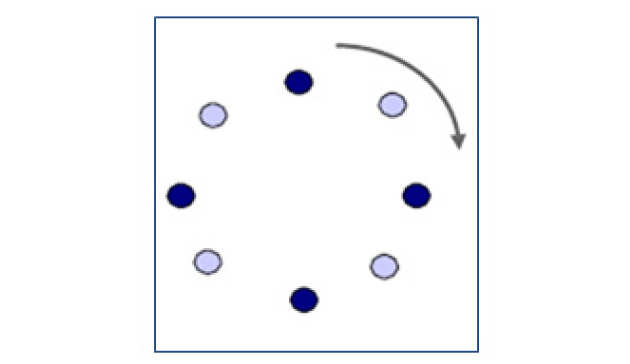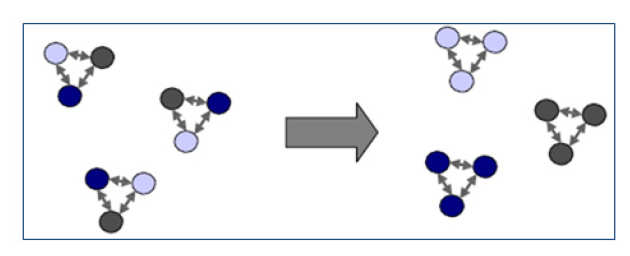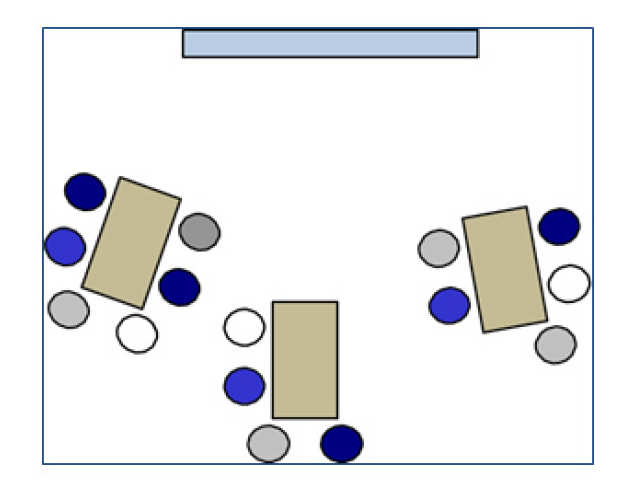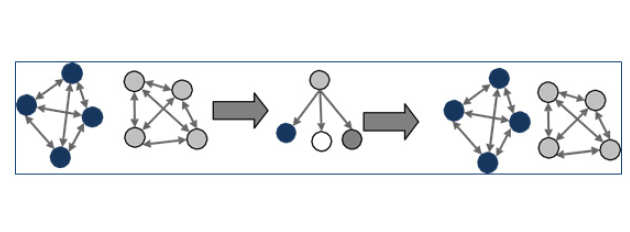The physical learning environment can also significantly impact on the group dynamics and level of interaction.
Group round
 A group round can be used as an ice breaker exercise and is a useful way of ensuring that everybody talks, they are also useful for establishing basic facts before an activity. Each person has a brief chance to talk, direction can be set or random, it can be more interesting if first contributor chooses the second etc. and the tutor can join in or observe from inside or outside the ‘circle’. Depending on the time allocated to each individual this technique could be used for groups of up to about 30, possibly more with very simple tasks and interactions and can help establish group responsibility and control. It can be done with large numbers, but works best in groups of around twenty.
A group round can be used as an ice breaker exercise and is a useful way of ensuring that everybody talks, they are also useful for establishing basic facts before an activity. Each person has a brief chance to talk, direction can be set or random, it can be more interesting if first contributor chooses the second etc. and the tutor can join in or observe from inside or outside the ‘circle’. Depending on the time allocated to each individual this technique could be used for groups of up to about 30, possibly more with very simple tasks and interactions and can help establish group responsibility and control. It can be done with large numbers, but works best in groups of around twenty.
Buzz groups and snowball
This is perhaps the most common process for student interaction; larger groups are broken into twos or threes for discussion which can be ‘free’ or you can specify people take turns to talk.

The groups of twos or threes can then be joined to make larger groups, ‘snowballing’ into a larger group. When joining groups in this way it helps if the task increases for each ‘join’ to prevent boredom. This can distribute ideas in, and is a useful way of ‘sampling’ a large class.
Can be used in very large (200+) groups, is good for getting everybody talking and is a good way of sharing knowledge and experience as well as giving students confidence that their own level of understanding (or not) is shared. This can help encourage them to participate in future questions and so on. Sampling a selection of buzz or snowball groups also allows the teacher to get a sense of the whole class.
Crossover groups
 These are a more directed version of snowball groups; students are divided into smaller sub-groups for work or discussion, then in a second time period groups are purposefully reorganised to redistribute students with the second configuration having a member from each of the first. The groups are formed and reformed under the control of the teacher rather than more randomly as is often the case with buzz groups and snowballing. This is so that ideas and discussions from the initial groups are then distributed to the class for further discussion and the crossover of information is maximised.
These are a more directed version of snowball groups; students are divided into smaller sub-groups for work or discussion, then in a second time period groups are purposefully reorganised to redistribute students with the second configuration having a member from each of the first. The groups are formed and reformed under the control of the teacher rather than more randomly as is often the case with buzz groups and snowballing. This is so that ideas and discussions from the initial groups are then distributed to the class for further discussion and the crossover of information is maximised.
This can be useful for distributing experience and knowledge in quite large groups and can also be used to manage individuals, i.e. encouraging the shy/quiet and/or simply splitting up groups of friends who always work together.
Jigsaw groups
 Students are divided into sub-groups, one for each sub-topic, each person is allocated a topic to become ‘expert’ in. Students go away and study their own topic, if time and numbers allow, students all researching the same topic can meet outside the class and then in a second lesson each topic ‘expert’ shares their findings with their jigsaw group. Typically this approach is used in conjunction with a small project or presentation. This process brings learning ‘outside’ the classroom back into the classroom and distributes it. It can be used with a relatively large group to manage individuals and also encourage them to find or develop their own interests within the class.
Students are divided into sub-groups, one for each sub-topic, each person is allocated a topic to become ‘expert’ in. Students go away and study their own topic, if time and numbers allow, students all researching the same topic can meet outside the class and then in a second lesson each topic ‘expert’ shares their findings with their jigsaw group. Typically this approach is used in conjunction with a small project or presentation. This process brings learning ‘outside’ the classroom back into the classroom and distributes it. It can be used with a relatively large group to manage individuals and also encourage them to find or develop their own interests within the class.
Horseshoe groups
 Groups are arranged around tables with each group arranged in a horseshoe around the screen/board this allows the teacher to mix ‘lecture’ and discussion formats. Each group can do the discussion work in any format e.g. buzz groups, crossovers, circular questioning etc., but can then re-convene to get direction and or material from the teacher at the front. This is a good way of mixing the interactive and the more traditional didactic approaches but needs space to maintain effect sight lines to the board and for suitable group work. Space is often the limiting factor for group size and numbers will depend on the flexibility of the room.
Groups are arranged around tables with each group arranged in a horseshoe around the screen/board this allows the teacher to mix ‘lecture’ and discussion formats. Each group can do the discussion work in any format e.g. buzz groups, crossovers, circular questioning etc., but can then re-convene to get direction and or material from the teacher at the front. This is a good way of mixing the interactive and the more traditional didactic approaches but needs space to maintain effect sight lines to the board and for suitable group work. Space is often the limiting factor for group size and numbers will depend on the flexibility of the room.
Market place
 This is similar to jigsaw groups, but here as you give all the required information there is no need for self-study or research outside the class and this can be done in one session.
This is similar to jigsaw groups, but here as you give all the required information there is no need for self-study or research outside the class and this can be done in one session.
First divide the topic content into smaller ‘chunks’ and then split the students into sub-groups and allocate each a topic 'chunk'. Give them time to discuss and become familiar with their information and to distil out the key information. You can provide specific guidance and/or impose specific limits or directions to this, for example to use the information to produce a summary diagram or poster. When this stage is complete each sub-group decides on one student who will present/teach their information and the others disperse around the room to gather information from the other sub-group ‘teachers’. Once this is done the students re-form their sub-groups and share their knowledge. At this final stage you can quiz to assess the students’ learning and teach or set other tasks as appropriate.
Broken pieces
This is a potentially useful approach to problem solving, where rather than providing students with all the information and ready-made solutions you break things up to encourage collaborative problem solving. Take a reasonably challenging and engaging problem and then provide different students with different pieces of the information they require to solve the problem. The group then have to collaborate in order to solve the problem. You can increase or direct the challenge by, for example missing out key pieces of information or limiting or directing how students can share information.
